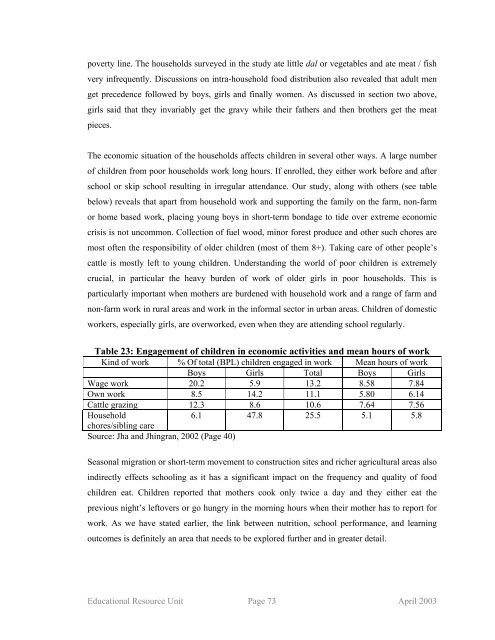Snakes and Ladders - ERU Consultants Pvt. Ltd.
Snakes and Ladders - ERU Consultants Pvt. Ltd.
Snakes and Ladders - ERU Consultants Pvt. Ltd.
Create successful ePaper yourself
Turn your PDF publications into a flip-book with our unique Google optimized e-Paper software.
poverty line. The households surveyed in the study ate little dal or vegetables <strong>and</strong> ate meat / fish<br />
very infrequently. Discussions on intra-household food distribution also revealed that adult men<br />
get precedence followed by boys, girls <strong>and</strong> finally women. As discussed in section two above,<br />
girls said that they invariably get the gravy while their fathers <strong>and</strong> then brothers get the meat<br />
pieces.<br />
The economic situation of the households affects children in several other ways. A large number<br />
of children from poor households work long hours. If enrolled, they either work before <strong>and</strong> after<br />
school or skip school resulting in irregular attendance. Our study, along with others (see table<br />
below) reveals that apart from household work <strong>and</strong> supporting the family on the farm, non-farm<br />
or home based work, placing young boys in short-term bondage to tide over extreme economic<br />
crisis is not uncommon. Collection of fuel wood, minor forest produce <strong>and</strong> other such chores are<br />
most often the responsibility of older children (most of them 8+). Taking care of other people’s<br />
cattle is mostly left to young children. Underst<strong>and</strong>ing the world of poor children is extremely<br />
crucial, in particular the heavy burden of work of older girls in poor households. This is<br />
particularly important when mothers are burdened with household work <strong>and</strong> a range of farm <strong>and</strong><br />
non-farm work in rural areas <strong>and</strong> work in the informal sector in urban areas. Children of domestic<br />
workers, especially girls, are overworked, even when they are attending school regularly.<br />
Table 23: Engagement of children in economic activities <strong>and</strong> mean hours of work<br />
Kind of work % Of total (BPL) children engaged in work Mean hours of work<br />
Boys Girls Total Boys Girls<br />
Wage work 20.2 5.9 13.2 8.58 7.84<br />
Own work 8.5 14.2 11.1 5.80 6.14<br />
Cattle grazing 12.3 8.6 10.6 7.64 7.56<br />
Household<br />
chores/sibling care<br />
6.1 47.8 25.5 5.1 5.8<br />
Source: Jha <strong>and</strong> Jhingran, 2002 (Page 40)<br />
Seasonal migration or short-term movement to construction sites <strong>and</strong> richer agricultural areas also<br />
indirectly effects schooling as it has a significant impact on the frequency <strong>and</strong> quality of food<br />
children eat. Children reported that mothers cook only twice a day <strong>and</strong> they either eat the<br />
previous night’s leftovers or go hungry in the morning hours when their mother has to report for<br />
work. As we have stated earlier, the link between nutrition, school performance, <strong>and</strong> learning<br />
outcomes is definitely an area that needs to be explored further <strong>and</strong> in greater detail.<br />
Educational Resource Unit Page 73 April 2003












